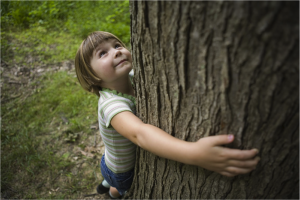 Children love the Earth. They really do hug trees. Kids care in the purest and sweetest way for birds, flowers, plants, and animals. To see children smell a flower, marvel at a bee buzzing around them, and jump with joy at seeing a deer are just a few of the ways that children express their connection, love, and awe for Mother Nature. They wouldn’t want to do anything to harm it. And they would be really mad at their parents if they learned what was being done to their Earth.
Children love the Earth. They really do hug trees. Kids care in the purest and sweetest way for birds, flowers, plants, and animals. To see children smell a flower, marvel at a bee buzzing around them, and jump with joy at seeing a deer are just a few of the ways that children express their connection, love, and awe for Mother Nature. They wouldn’t want to do anything to harm it. And they would be really mad at their parents if they learned what was being done to their Earth.
Regardless of where you stand on the issue of climate change, I hope there is no argument that, environmentally speaking, we simply can’t sustain our current path for much longer. Air pollution caused by the growing number of automobiles on the road and coal-burning power plants worldwide. Our oceans and seas being fished out. Massive deforestation. Billions of people globally who are rising to the middle classes demanding more of everything. The list goes on.
And who will suffer from our disregard for the health of Planet Earth? The answer is our children. And my next series of posts is about our children and the Earth that they will inherit. My plea is to hand the keys to our planet over to our children in reasonable condition so that Earth will have many more miles around the sun ahead of it and our children and their children can enjoy its many wonders as we have.
The sad reality is that our children will be inheriting an environmental mess. Even more sadly, by the time they grow up, most of them will become a part of the problem rather than a part of the solution. In our voraciously consumptive culture, many if not most children are being sent messages that will continue the environmentally destructive legacy of their parents.
The only hope our planet has is if parents choose to send very different messages that will result in raising “green children.” Parents can connect that wonderful feeling that children have for nature while they are young with a sensitivity to the impact they can have on the Earth and a sense of environmental stewardship for how they can help protect it in the future. We all love our children and want them to have a bright future. A part of that bright future should be the condition of our planet that we pass on to them. If parents can send the right “green” messages to their children, then perhaps they will care enough about Mother Earth to work to undo the damage their parents caused to it.
A wonderful book, Teaching Green, offers parents the first four ideas below (the rest come from me) on how to help children develop a deep connection to nature that can result is a commitment to and sense of stewardship for the future health of our planet.
Develop a Personal Relationship with Nature
At the heart of this connection with nature is the love that I just discussed. The fact is that children will want to take care of Mother Earth because they care for it. And children will care more about nature if they have a relationship with it. And the only way to develop such a relationship is for children to experience nature fully; they must walk in, play, explore, see, touch, and smell it. Experiences that are rich with sensory stimulation, engage intellectually and emotionally, and directly relate to the natural world act as the “hook” that makes children feel not only connected to, but also an integral part of nature.
Emphasize Connection Between People and Nature
Because children don’t have much life experience, they can’t readily see the connections that we have with nature and other peoples. We are far more connected than children (and many adults) realize through what we eat, what we wear, and what we use in our daily lives, and how we move about. Recognition of this interdependence between ourselves, nature, and others shows children how their everyday actions impact Earth and its inhabitants.
From Awareness to Action
Understanding and stewardship of Mother Earth begins when children gain an awareness of the natural world in which they live through hands-on experience. That awareness hopefully will then pique their curiosity and inspire them to gain knowledge about how nature works. This knowledge then bestows on children the desire and capacity to act to protect Earth.
Past, Present, and Future
Because children have little experience, they tend to view the world in the present. When children study nature, they are able to expand their perspective to include the past, present, and future. They can learn about how the Earth used to be and how nature has evolved over the eons. Children can see how the evolution of both nature and humanity has resulted in our current state of the environment. They can then project Earth into the future and consider possible futures based on where we are now and if we made beneficial environmental changes. Then, as children gain both a love and understanding for nature, they can project themselves into the future and contemplate how their actions might help foster the future that they most envision.
Nature’s Impact on Families
You can have such a powerful influence on your children in their attitudes toward the Mother Earth because just about everything you do has an impact on the environment. From the moment you wake up, you use water and electricity (e.g., heat house, turn on lights, brush your teeth, wash your face, flush toilet). When you eat breakfast, you store, select, and prepare certain foods and drink (e.g., appliance energy use, carbon footprint of food, water use for cleaning dishes). The means by which you get to work and your children get to school (e.g., walk, bike, car, public transportation). Where you shop for groceries (e.g., supermarket, farmers’ market). This use of our natural resources continues until you turn off your light and go to sleep (and, even then, it continues to a lesser extent all through the night).
Walk the Walk on Being Green
The best messages you send are through role modeling and action. But I should point out that the messages you send will depend to some extent on where you live and the kind of life you lead. For example, in the city, you can send messages about taking the bus or subway rather than driving your car. In the suburbs, your messages might emphasize shopping at farmers’ markets and recycling. For those who live in the country, green messages might include growing your own food and heating your house with solar energy instead of oil, natural gas, or electricity.
Make Being Green Tangible
Regardless of the specific messages you send your children, the initiation into becoming green children involves allowing them to connect directly with Mother Earth and gain a real love for nature. As that feeling develops, you can teach them practical steps they can take, such as turning off lights and recycling, to honor and protect their planet. In doing so, you give your children several essential gifts. You connect them deeply with the most basic source of their lives. You educate them about the impact that they have on the Earth. And, importantly, you give them the power to ensure that Mother Earth continues to live a long and healthy life.
Be a Green Family
To help you figure out how you can model a green life for your children, a useful exercise is to look at your life and see all of the ways that you impact our planet. Questions to consider include where you live in, what and how much you drive, the types of food you eat and where you shop for groceries, what kind of waste do you generate and where does it go, and how much time you spend in nature. How you answer these questions will clarify the messages that you send your children about the environment. They can also provide you with direction on changes you might want to make in your family life to convey more green messages to your children.
This blog post is excerpted from my third parenting book, Your Children are Listening: Nine Messages They Need to Hear from You (The Experiment Publishing, 2011).






